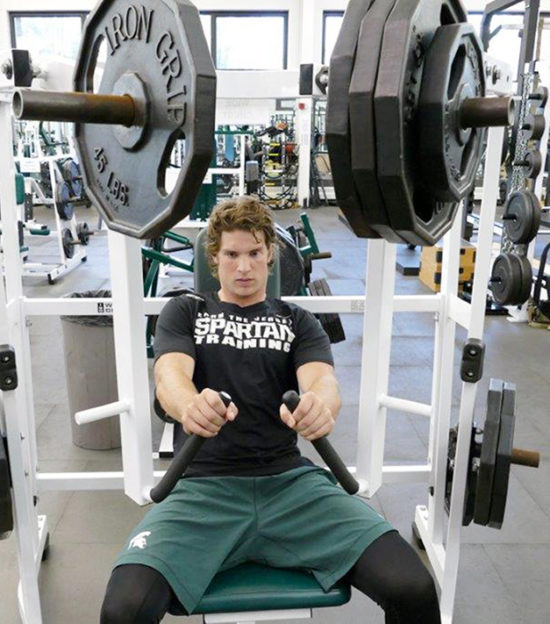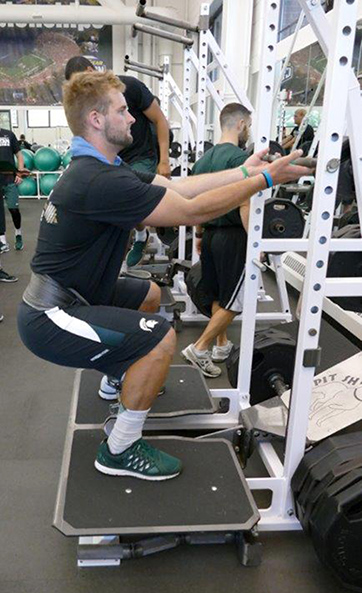Powerline: Managing daily priorities of a strength program
On just about a daily basis, I receive several email requests for a handout describing some aspect of our program — in/offseason training, conditioning protocols, speed training mechanics, mobility/flexibility, leadership activities and a wealth of other player development information.
While I certainly try to help these coaches with their requests, there remains a serious concern on my part as to whether a true understanding of what is really important gets lost in translation.

It’s human nature to ask for what is perceived to be a successful “program,” but it must be understood that a spreadsheet of sets, reps, percentages, volume or frequency does not automatically lead to the desired results. The analogy to a specific sport holds true — the best game plan can be rendered null and void without proper preparation, administration and execution.
Let’s take some time in this installment to review and emphasize some vital components that, while not as transparent as the information within a workout script, are precursors to safe, effective execution and management of any given exercise regimen.
Know your numbers
Before you can run a successful business, you need to know numbers like the company’s valuation, product margins, overhead, inventory, wages and benefits or you will not be in business for very long. It’s the same with running a successful training program.
The following administrative variables are crucial to the effectiveness of any system that is incorporated.
- The number of athletes training during each session.
- The total training blocks of time available each day.
- The time allotted for each specific training session.
- The size of the facility, its functionality and its ability to accommodate the given number of athletes training.
- The amount and types of equipment available for training with regard to meeting the goals and objectives of each training session.
A glaring problem with many of the high school strength programs I’ve observed is the overcrowding of the weight room. This occurrence usually disintegrates into a social event rather than a purposeful, result-producing training session. When a coach tells me that his team “lifted for an hour and a half,” I always respond with, “How much work was actually accomplished during that time?”
Organizing and administrating training schedules — especially at the high school level, where a multitude of male and female teams want access to the weight room — requires diligence and cooperation on everyone’s part. Obviously, several teams cannot storm the weight room at the end of the school day if the room size, capacity restrictions, equipment situation and other considerations are not conducive to a safe, productive training environment.
A rotation of days, times, training durations and weekly frequencies (based upon in-season or offseason periods) must be discussed, agreed upon and adhered to as the year progresses. In my opinion, the athletic director, head coaches of each sport, the designated strength and conditioning coach (preferably one with an accredited certification) and the school’s certified athletic trainer should all meet and set policies in this regard.
Balance the workouts
 When reviewing the strength training scripts coaches send to me for review and evaluation, the majority of them either do not place enough emphasis on the posterior chain musculature.
When reviewing the strength training scripts coaches send to me for review and evaluation, the majority of them either do not place enough emphasis on the posterior chain musculature.
The body’s posterior chain musculature consists of the upper back compartments (i.e., trapezius segments, posterior shoulder, rhomboid/scapula area, erector spinae region, gluteal and hamstring group).
To accomplish this, pulling movements for the upper body (various rowing, pulldown, scapular retraction exercises, etc.) and back extensions, glute-ham, leg curl, Romanian dead lifts and the Nordic hamstring exercise for the lower body should be performed liberally. Pairing pressing and pulling movements can prove to be an extremely efficient and efficacious training methodology.
A well-constructed agonist/antagonist script protocol accomplishes the following:
- Improve the overall structural stability of joint areas, as all of the surrounding compartments receive an optimal training stimulus.
- Increases the synergistic potential of both the agonist in acceleration, thus improving power output and capability of the antagonist to decelerate the action, which is a principal constituent in quick, safe and efficient limb movements.
- Improves flexibility and mobility with concurrent strength increases, which ultimately enhances power production and movement speed.
Match programs with age, experience
This is my major caveat when providing high school coaches with training material. What is appropriate for the collegiate level athlete may be cautionary, or even ill advised, for younger athletes. In a similar vein, some of the techniques and protocols utilized by NFL players do not synchronize well with collegiate freshmen athletes. It must be understood that there can be significant differences between chronological and physiological development, maturity, growth potential and recovery capabilities when transitioning through this dichotomy of age groups.
Here are some basic guidelines to follow with novice trainees:
- Keep it simple in the early stages. Start with very basic, easily mastered movements that require nominal skill acquisition. Doing so allows for an effort emphasis, as opposed to a complicated skill emphasis.
- Repetitions should be moderate to high (e.g., in the eight to 15 range). Preadolescents, and even a large contingent of adolescents, need not perform one-repetition maximum attempts. The exception is older adolescents who partake in competitive weightlifting, which are highly skill dependent.
In terms of training the non-competitive weightlifting athlete in this age group, moderate to higher reps increase time under tension (TUT), which has a positive influence on muscle fiber recruitment, and cellular and molecular signaling, which are fundamental to the stimulation of muscle protein synthesis and muscle hypertrophy. The result is increased growth and strength, attained in an age appropriate fashion.
Training for speed
When a coach asks me about developing speed and quickness, I respond with a question of my own: “Do you train for speed and quickness independently?” These are very specific training outcomes, and they are both determined by a host of variables, some of which are not easily attained.
 For instance, if the athlete in question is not “cut right” from the standpoints of body composition, leverage, neuromuscular, cognitive and biomechanical abilities and capabilities, a long, unforgiving road is ahead. The rate and level of high-end speed improvement is based more upon these genetic factors than any high-tech, guru program in existence.
For instance, if the athlete in question is not “cut right” from the standpoints of body composition, leverage, neuromuscular, cognitive and biomechanical abilities and capabilities, a long, unforgiving road is ahead. The rate and level of high-end speed improvement is based more upon these genetic factors than any high-tech, guru program in existence.
This is especially true of the athlete’s neuromuscular efficiency, or the speed and accuracy with which neural information is sent and received along the brain-to-muscle pathway. This paramount factor alone speaks to the rate-limiting or rate-improvement outcomes that are pre-determined from a genetic standpoint.
I seriously doubt that any speed/quickness improvement program on the market is taking athletes from a 4.8 to a 4.4 in the 40-yard dash on a regular basis, if at all. If one exists, it is pure gold, but before making a wholesale investment in it, know that it is a buyer-beware proposition.
Regardless of the speed mechanics approach you’ve adopted, my recommendation is that it be implemented independently of other training procedures.
For example, schedule speed training sessions on non-lifting days whenever possible. In the very least, lifting workouts should be performed after speed sessions in instances where you feel the need to do both. The rationale for this is simple: You do not want do induce any neural or muscular fatigue to the system leading into a speed training session that detracts from optimal performance.
The overriding premise is this: In order to develop speed, you must train at full speed.
Regarding the scheduling of the weight room and the speed/quickness training area, cooperation among coaches must be in play to avoid overcrowding in any one facility at a given time.
Account for injured athletes
Nothing is more aggravating, frustrating and depressing for young athletes who love the game they play than to be sidelined with an injury.
Here are a few suggestions for easing the mental anguish and working toward a safe, expeditious return to play:
- Work closely with the medical staff on the timing for initiating strength work around the injured area. In some circumstances, the specific injury site and the adjacent structures may need to be kept quiet for a lengthy period. Conversely, strength training for contralateral or superior (above) and inferior (below) joint complexes may be able to be safely trained.
- As mentioned in previous columns, unilateral machine work provides an ideal starting point, as the athlete will have an easier time balancing the load. Additionally, there is a built-in safety mechanism in that if the load is inadvertently dropped — or a contraction “deficit” surfaces — the weight can be lowered without incident. Progression to free-weight modes can follow from there.
- Keep tracking progress, as it is a key ingredient in all training endeavors, especially the rehab process. Remember that the athlete has a new starting point, which can be significantly below what had been the status quo for so long. This can be a severe blow to the psyche, and one of the ways to soothe the ego is to be able to point to some positive, concrete progress results, even if they are coming at a snail’s pace.
Ken Mannie is the head strength and conditioning coach Michigan State University. His column, Powerline, appears regularly in Coach & Athletic Director magazine.


